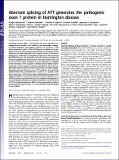| dc.contributor.author | Sathasivam, Kirupa | |
| dc.contributor.author | Neueder, Andreas | |
| dc.contributor.author | Landles, Christian | |
| dc.contributor.author | Benjamin, Agnesska C. | |
| dc.contributor.author | Bondulich, Marie K. | |
| dc.contributor.author | Smith, Donna L. | |
| dc.contributor.author | Faull, Richard L. M. | |
| dc.contributor.author | Roos, Raymund A. C. | |
| dc.contributor.author | Howland, David | |
| dc.contributor.author | Detloff, Peter J. | |
| dc.contributor.author | bates, Gillian P. | |
| dc.contributor.author | Wasylenko, Theresa Anne | |
| dc.contributor.author | Housman, David E | |
| dc.date.accessioned | 2013-09-11T15:08:06Z | |
| dc.date.available | 2013-09-11T15:08:06Z | |
| dc.date.issued | 2013-01 | |
| dc.date.submitted | 2012-12 | |
| dc.identifier.issn | 0027-8424 | |
| dc.identifier.issn | 1091-6490 | |
| dc.identifier.uri | http://hdl.handle.net/1721.1/80388 | |
| dc.description.abstract | Huntington disease (HD) is a devastating, late-onset, inherited neurodegenerative disorder that manifests with personality changes, movement disorders, and cognitive decline. It is caused by a CAG repeat expansion in exon 1 of the HTT gene that translates to a polyglutamine tract in the huntingtin protein (HTT). The formation of HTT fragments has been implicated as an essential step in the molecular pathogenesis of HD and several proteases that cleave HTT have been identified. However, the importance of smaller N-terminal fragments has been highlighted by their presence in HD postmortem brains and by the fact that nuclear inclusions are only detected by antibodies to the N terminus of HTT. Despite an intense research effort, the precise length of these fragments and the mechanism by which they are generated remains unknown. Here we show that CAG repeat length–dependent aberrant splicing of exon 1 HTT results in a short polyadenylated mRNA that is translated into an exon 1 HTT protein. Given that mutant exon 1 HTT proteins have consistently been shown to be highly pathogenic in HD mouse models, the aberrant splicing of HTT mRNA provides a mechanistic basis for the molecular pathogenesis of HD. RNA-targeted therapeutic strategies designed to lower the levels of HTT are under development. Many of these approaches would not prevent the production of exon 1 HTT and should be reviewed in light of our findings. | en_US |
| dc.description.sponsorship | Cure Huntington’s Disease Initiative, Inc. | en_US |
| dc.language.iso | en_US | |
| dc.publisher | National Academy of Sciences (U.S.) | en_US |
| dc.relation.isversionof | http://dx.doi.org/10.1073/pnas.1221891110 | en_US |
| dc.rights | Article is made available in accordance with the publisher's policy and may be subject to US copyright law. Please refer to the publisher's site for terms of use. | en_US |
| dc.source | PNAS | en_US |
| dc.title | Aberrant splicing of HTT generates the pathogenic exon 1 protein in Huntington disease | en_US |
| dc.type | Article | en_US |
| dc.identifier.citation | Sathasivam, K., A. Neueder, T. A. Gipson, C. Landles, A. C. Benjamin, M. K. Bondulich, D. L. Smith, et al. “Aberrant splicing of HTT generates the pathogenic exon 1 protein in Huntington disease.” Proceedings of the National Academy of Sciences 110, no. 6 (February 5, 2013): 2366-2370. | en_US |
| dc.contributor.department | Massachusetts Institute of Technology. Department of Biology | en_US |
| dc.contributor.department | Koch Institute for Integrative Cancer Research at MIT | en_US |
| dc.contributor.mitauthor | Gipson, Theresa Anne | en_US |
| dc.contributor.mitauthor | Housman, David E. | en_US |
| dc.relation.journal | Proceedings of the National Academy of Sciences | en_US |
| dc.eprint.version | Final published version | en_US |
| dc.type.uri | http://purl.org/eprint/type/JournalArticle | en_US |
| eprint.status | http://purl.org/eprint/status/PeerReviewed | en_US |
| dspace.orderedauthors | Sathasivam, K.; Neueder, A.; Gipson, T. A.; Landles, C.; Benjamin, A. C.; Bondulich, M. K.; Smith, D. L.; Faull, R. L. M.; Roos, R. A. C.; Howland, D.; Detloff, P. J.; Housman, D. E.; Bates, G. P. | en_US |
| dc.identifier.orcid | https://orcid.org/0000-0002-0524-5301 | |
| dc.identifier.orcid | https://orcid.org/0000-0001-5016-0756 | |
| mit.license | PUBLISHER_POLICY | en_US |
| mit.metadata.status | Complete | |
